Slonta
Q82075991Slonta: native sanctuary in the Cyrenaica.
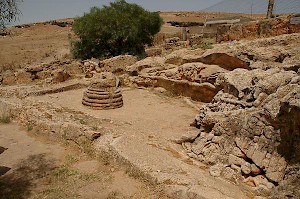
Slonta is like a Hieronymus Bosch painting made of stone. On this archaeological site, south of Cyrene, you will see the weirdest creatures cut into the rock by native Libyan artists. No one knows why they were made, no one knows when, but the column base offers a clue: in an age when column bases were used, which means in the Greek or Roman period.
The site, known in Arab as El Tesuira ("picture gallery"), used to be a cave, but the roof has collapsed. The interior was once dominated by a sculpture of a big snake. This curious mix of limbs, surrounding something resembling a head, was found on the floor and has been removed to a safer place.
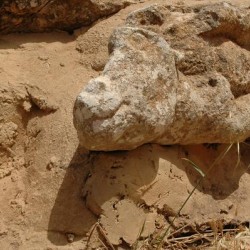 Slonta, Snake's tail |
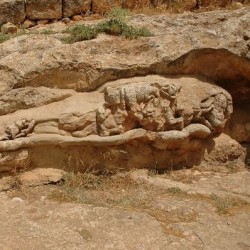 Slonta, Snake |
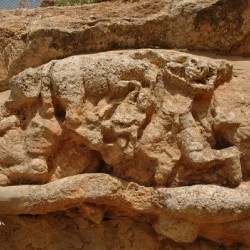 Slonta, Snake and humans |
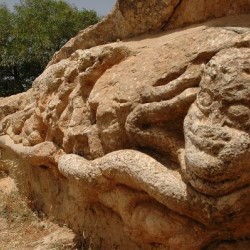 Slonta, Snake's head |
The site has been identified as a temple or another type of religious site, but this is a weak bid. When archaeologists do not know what they have excavated, it is always something religious, and preferably has something to do with fertility, or death, or both. In his book The Archaeology of Cult (1986), British archaeologist Colin Renfrew has tried to establish criteria to identify cultic sites without running the risk of misinterpreting an ancient toy shop. One of these criteria is the presence of a well, because sources are often venerated. Slonta fits this criterion and may indeed have been a sanctuary.
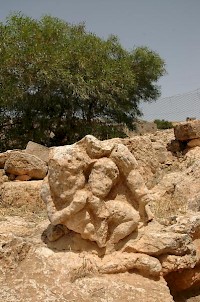
This big snake, which has a human head, can still be seen along the northern wall of the cave. These animals played a role in the religious beliefs of the ancient Libyans.note Maybe it was a totem animal. It is intriguing that the Roman author Pliny the Elder tells that there used to be a tribe living west of Slonta, the Psylli, that had been immune to snake bites.
Their custom was to expose children at birth to extremely fiery snakes, and to use these snakes to test to faithfulness of their wives, since snakes do not flee people born of adulterous blood. The tribe has almost been wiped out by the Nasamones [...]. However, a tribe descended from them [...] lives on in a few places.note
Perhaps Slonta was created by these descendants of the Psylli, and perhaps this cave was used to expose the babies - we simply don't know. On the back of the snake, we can see these two men: the one to the left is reclining, the one to the right appears to be afraid of the unidentified animal between them.
This animal, near the tail of the serpent, looks like a cow or goat without horns. According to the Greek researcher Herodotus of Halicarnassus,
They cut off a part of the animal's ear as a first offering and throw it over the tent, and having done this they wring its neck. They sacrifice only to the Sun and the Moon.note
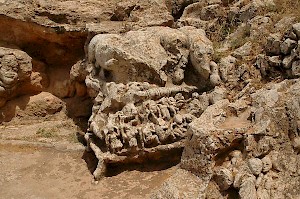
In the eastern part of the wall are reliefs of four pigs, standing over a group of many human figures. Interpretation of these reliefs is completely impossible, but if you look carefully, you can see that the people are standing on something that looks like a table with legs. Probably, this was some sort of altar, and it is possible that the pigs were stone representations of the sacrifice. Alternatively, the pigs are about to devour the people.
The numerous human figures on the table are shown with their hands close to their heads. Maybe the woman to the left beats herself over the head with a small flagrum, or a tree branch. They appear to be afraid of something, or are weeping as if they are mourning women. Herodotus remarks that he thinks that
in these regions first arose the practice of crying aloud during the performance of sacred rites, for the Libyan women do this very well.note
(It is perhaps interesting to note that Herodotus uses a word for "crying aloud", ololyge, that is related to our Hallelujah.) Immediately right of the snake's human head, and to the left of the four pigs, is a part of the cave that is still intact. If the identification of the pigs as an altar is correct, this cave may have been the most sacred place.
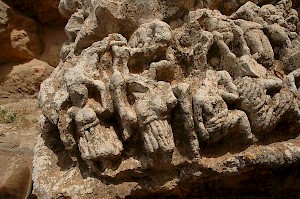
Next to the entrance are these stone heads with very large eyes. These "bodiless heads" have been discovered on several places around the Mediterranean world, and pose a little problem: they are too old to belong to the same period as the column base. Probably, these heads are the oldest sculptures at Slonta, to which the other reliefs were added in the Graeco-Roman period.
All these decorations are unique because they were made by the indigenous population. Except for the column that must have been in the center of the room, Greek and Roman elements are completely absent. This is remarkable because Slonta is along the ancient road from Derna to Berenice (modern Benghazi).
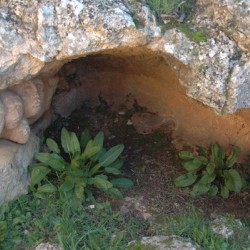 Slonta, Cave with heads |
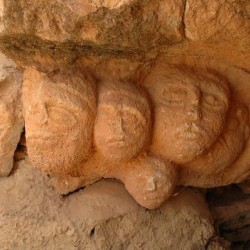 Slonta, Heads |
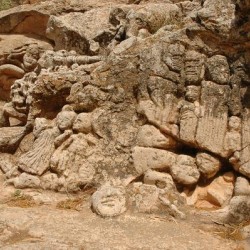 Slonta, Scared people |
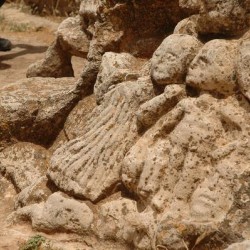 Slonta, Scared people |
There are also sculptures to the east, which must have been at the entrance of the cave. The seven figures may represent children. Three of them have long robes, and they look as if they are terribly scared. If Slonta as a whole reminds one of a Hieronymus Bosch, this figure resembles Edvard Munch's Scream. Although we have no idea about the deity venerated at Slonta, it is not unlikely that (s)he had something to with the Underworld. Unless, of course, it was not a sanctuary at all.